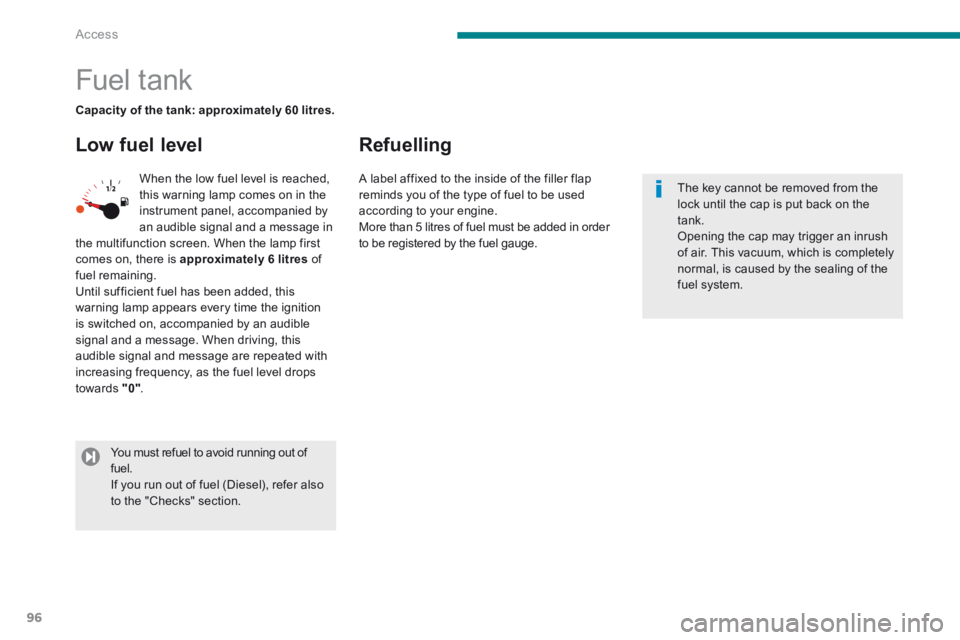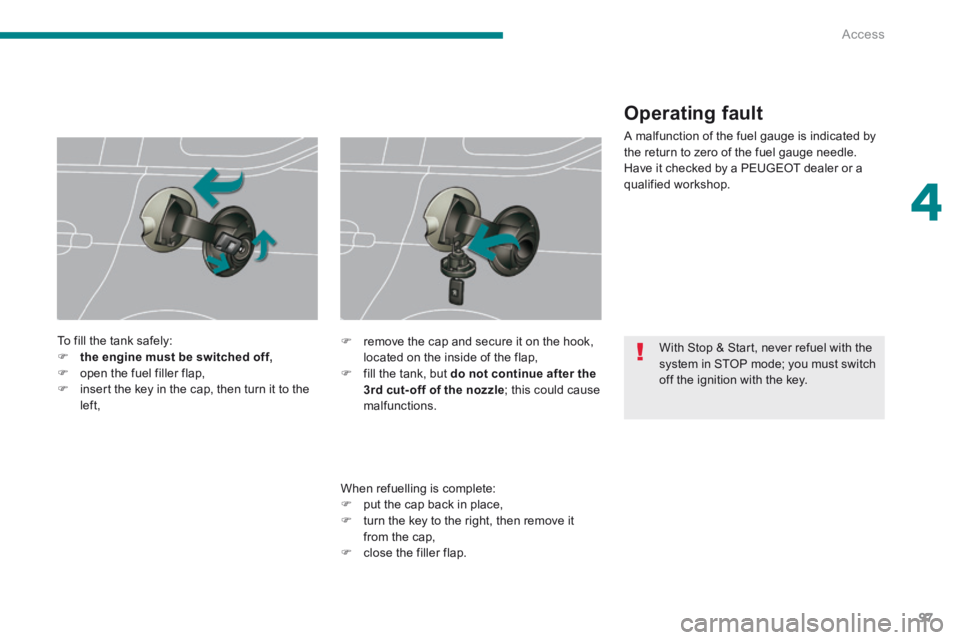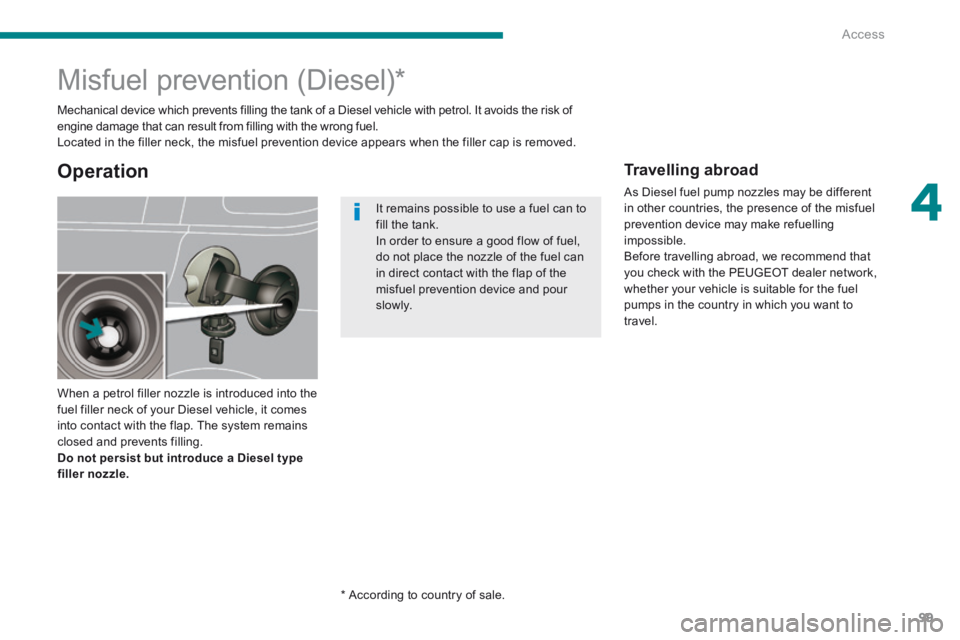2013.5 PEUGEOT 5008 fuel cap
[x] Cancel search: fuel capPage 8 of 404

81
105
96
Familiarisation
6
Access
Remote control key
A. Unfolding / Folding the key.
Normal locking (press once; fixed lighting of the direction indicators).
Deadlocking the vehicle (press twice in succession; fixed lighting of the direction indicators).
Complete or selective unlocking of
the vehicle (rapid flashing of the direction i n di c ato r s).
or
When the light is poor, detected by a sensor, the remote switching on of the dipped beam headlamps and sidelamps makes your approach to the vehicle easier. This function can be programmed via the configuration menu.
Fuel tank
1. Opening the fuel filler flap. 2. Opening and hooking the fuel filler cap.
The type of fuel to be used is indicated on the inner face of the fuel filler flap.
Capacity of the tank: approximately 60 litres.
Welcome lighting
On Diesel vehicles, the fuel filler neck incorporates a misfuel prevention device which prevents filling with petrol.
Page 38 of 404

Monitoring
36
Warning lampis onCauseAction/Observations
Engine autodiagnosis system
flashing. The engine management system has a fault. Risk of destruction of the catalytic converter. Have it checked by a PEUGEOT dealer or a qualified workshop.
fixed. The emission control system has a fault. The warning lamp should go off when the engine is started. If it does not go off, contact a PEUGEOT dealer or qualified workshop without delay.
Low fuel level fixed with the needle in the red zone. When it first comes on there remains approximately 6 litres of fuel in the tank. At this point, you begin to use the fuel reserve.
Refuel as soon as possible to avoid running out of fuel. This warning lamp will come on every time the ignition is switched on, until a sufficient addition of fuel is made. Fuel tank capacity: approximately 60 litres . Never continue to drive until you run out of fuel, as this could damage the emission control and injection systems.
Maximum coolant temperature fixed with the needle in the red zone. The temperature of the cooling system is too high. Stop as soon as it is safe to do so. Wait until the engine has cooled down before topping up the level, if necessary. If the problem persists, contact a PEUGEOT dealer or a qualified workshop.
Dynamic stability control (DSC/ASR)
flashing. The DSC/ASR regulation is operating. The system optimises traction and improves the directional stability of the vehicle.
fixed. Unless it has been deactivated (button pressed and its indicator lamp on) the DSC/ASR system has a fault.
Have it checked by a PEUGEOT or a qualified workshop.
Page 61 of 404

3
Comfort59
The air conditioning system does not contain chlorine and does not present any danger to the ozone layer.
Recommendations for ventilation and air conditioning
In order for these systems to be fully effective, follow the operation and maintenance guidelines below: If the interior temperature remains very high after the vehicle has been parked in the sun for a considerable time, first ventilate the passenger compartment for a few minutes. Place the air flow control at a sufficient level to provide an adequate renewal of air in the passenger compartment. To obtain an even air distribution, take care not to obstruct the exterior air intake grilles located at the base of the windscreen, the nozzles, the vents and the air outlets, as well as the air extractor located in the boot. Use in preference the intake of exterior air as prolonged use of the air recirculation may cause misting of the windows and side windows. Do not cover the sunshine sensor, located on the dashboard; this is used for regulation of the automatic air conditioning system. Operate the air conditioning system for 5 to 10 minutes, once or twice a month to keep it in good working order. Ensure that the passenger compartment filter is in good condition and have the filter elements replaced regularly (refer to the "Checks" section). We recommend the use of a combined passenger compartment filter. Thanks to its second special active filter, it contributes to the purification of the air breathed by the occupants and the cleanliness of the passenger compartment (reduction of allergic symptoms, bad odours and greasy deposits). The air conditioning uses power from the engine while operating. This results in an increase in the vehicle's fuel consumption. When towing at or near maximum capacity or on steep slopes in high ambient temperatures, switching off the air conditioning saves engine power and so improves towing capacity. Condensation created by the air conditioning results in a discharge of water under the vehicle when stationary, which is per fectly normal. To ensure correct operation of the air conditioning system, you are also advised to have it checked regularly. If the system does not produce cold air, do not use it and contact a PEUGEOT dealer or a qualified workshop.
Rear ventilation
adjustment
After pressing the "REAR" button, turn the adjustment dial of the rear side vents to decrease or increase the flow of air. Take care not to obstruct the side vents and the air outlets on the floor. To shut off the flow of air, close the vents and
set the dial to 0.
Page 98 of 404

Access
96
Fuel tank
Low fuel level Refuelling
When the low fuel level is reached, this warning lamp comes on in the instrument panel, accompanied by
an audible signal and a message in the multifunction screen. When the lamp first comes on, there is approximately 6 litres of fuel remaining. Until sufficient fuel has been added, this warning lamp appears every time the ignition is switched on, accompanied by an audible signal and a message. When driving, this audible signal and message are repeated with increasing frequency, as the fuel level drops towards "0" .
Capacity of the tank: approximately 60 litres.
The key cannot be removed from the lock until the cap is put back on the tank. Opening the cap may trigger an inrush of air. This vacuum, which is completely normal, is caused by the sealing of the fuel system.
You must refuel to avoid running out of fuel. If you run out of fuel (Diesel), refer also to the "Checks" section.
A label affixed to the inside of the filler flap reminds you of the type of fuel to be used according to your engine.
More than 5 litres of fuel must be added in order to be registered by the fuel gauge.
Page 99 of 404

4
Access97
With Stop & Start, never refuel with the system in STOP mode; you must switch off the ignition with the key.
To fill the tank safely: the engine must be switched off, open the fuel filler flap, insert the key in the cap, then turn it to the left,
When refuelling is complete: put the cap back in place, turn the key to the right, then remove it
from the cap, close the filler flap.
remove the cap and secure it on the hook, located on the inside of the flap, fill the tank, but do not continue after the 3rd cut- off of the nozzle ; this could cause malfunctions.
Operating fault
A malfunction of the fuel gauge is indicated by the return to zero of the fuel gauge needle. Have it checked by a PEUGEOT dealer or a qualified workshop.
Page 101 of 404

4
Access99
Misfuel prevention (Diesel) *
When a petrol filler nozzle is introduced into the fuel filler neck of your Diesel vehicle, it comes into contact with the flap. The system remains
closed and prevents filling. Do not persist but introduce a Diesel type filler nozzle.
* According to country of sale.
Mechanical device which prevents filling the tank of a Diesel vehicle with petrol. It avoids the risk of engine damage that can result from filling with the wrong fuel. Located in the filler neck, the misfuel prevention device appears when the filler cap is removed.
Operation
It remains possible to use a fuel can to fill the tank. In order to ensure a good flow of fuel, do not place the nozzle of the fuel can in direct contact with the flap of the misfuel prevention device and pour s l ow l y.
Travelling abroad
As Diesel fuel pump nozzles may be different in other countries, the presence of the misfuel prevention device may make refuelling impossible. Before travelling abroad, we recommend that you check with the PEUGEOT dealer network, whether your vehicle is suitable for the fuel pumps in the country in which you want to travel.
Page 209 of 404

10
Checks207
Diesel engines
The various caps and covers allow access for checking the levels of the various fluids, for replacing certain components and for priming the fuel system.
1. Power steering reservoir.
2. Screenwash and headlamp wash reservoir.
3. Coolant reservoir.
4. Brake fluid reservoir.
5. Battery/Fuses.
6. Fusebox.
7. Air filter.
8. Engine oil dipstick.
9. Engine oil filler cap.
10. Priming pump * .
11. Bleed screw * .
* According to engine.
Page 258 of 404

Technical data
256
Engine s 1.6 litre VTi 120 hp1.6 litre THP 150 / 156 / 163 hp
Gearbox Manual (5-speed) Manual (6-speed) Automatic (6-speed)
Cubic capacity (cc) 1 5 9 8 1 5 9 8
Bore x stroke (mm) 77 x 85.8 77 x 85.8
Max power: EU standard (kW) * 88 110 / 115 / 120
Max power engine speed (rpm) 5 6 6 0 6 000 - 6 050 / 6 000 / 6 000
Max torque: EU standard (Nm) 1 6 0 2 4 0
Max torque engine speed (rpm) 4 2 5 0 1 4 0 0
Fuel Unleaded Unleaded
Catalytic converter yes yes
Engine oil capacity, with filter replacement (in litres) 4 . 2 5 4 . 2 5
Petrol engines and gearboxes
* The maximum power corresponds to the type approved value on a test bed, under the conditions defined in European legislation (directive 1999/99/CE).